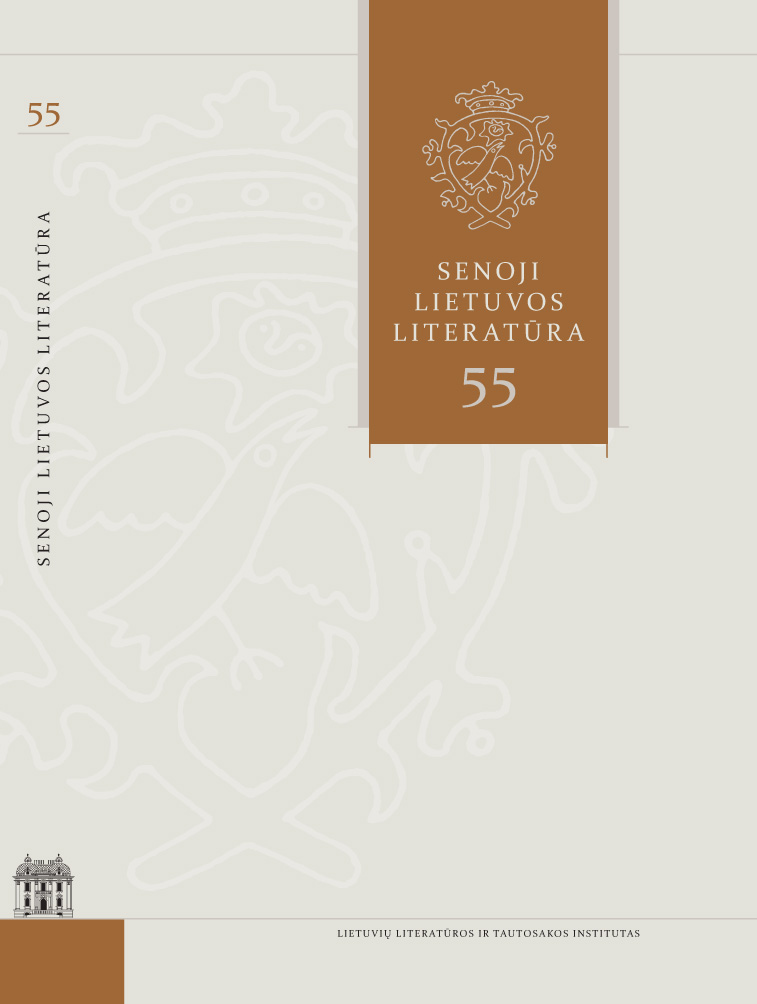The Pilgrimage Account of Mikalojus Kristupas Radvila Našlaitėlis: German Edition (1603)
Abstract
The article analyzes the first German translation (1603) of the description of the pilgrimage of Mikalojus Kristupas Radvila Našlaitėlis (pl. Mikołaj Krzysztof Radziwiłł „Sierotka“, 1549–1616). The pilgrimage of Radvila to Jerusalem, which occurred between 1582 and 1584, attracted significant public interest. It is believed that the duke wrote down his account of the pilgrimage around 1590- 1591, after which the manuscript circulated in copies. The distant holy sites, customs, and exotic nature of Egypt, along with the challenging conditions and perils faced by travelers, intrigued readers of various professions and religions. Consequently, the fifth edition of the pilgrimage account, titled ‘Hierosolymitana peregrinatio,’ emerged in 1601. The text’s popularity and the aspiration to disseminate it are evidenced by the subsequent translations. A German edition was published in Mainz just two years later (1603), followed by Polish translations of the pilgrimage description and the liturgy of the daily procession in the Basilica of the Holy Sepulchre in two separate books in 1607. The translator of German edition, Laurentius Borkowski (Laurentius a Borcken), accompanied the sons of Márton Berzeviczy, a confidant of King Stephen Bator, on a study trip and translated the text, which was then published in Mainz. It appeared in the catalog of the Frankfurt Book Fair of the same year. This text, which has not yet received attention from researchers, is primarily interesting due to its publishing history and paratexts. Laurentius Borkowski dedicated the translation to the young prince, the future king Władysław IV Vasa (1595– 1648). By explaining why the description of the pilgrimage would be interesting and useful for the young ruler, Borkowski provides a better understanding of how the text was received at that time. The article also discusses ‘The Dialogic Verse’ (Carmen dialogicum), a poetic conversation in Latin between the brothers John and Christophor, in which Radziwiłł the Orphan and the entire Vasa family are exalted. Finally, the aim is to identify the audience for which this translation was intended. While it appears to have been intended for the German-speaking population of the Polish–Lithuanian Commonwealth, the translator’s comment at the end of the text, which links the duke’s trip to the Great German Pilgrimage (1064–1065), also suggests an effort to garner the attention of the academic community in Mainz or even broader.

This work is licensed under a Creative Commons Attribution 4.0 International License.
Most read articles by the same author(s)
- Ona Aleknavičienė, Liucija Citavičiūtė, Mintautas Čiurinskas, Kęstutis Gudmantas, Raimonda Meyer-Ravaitytė, Simona Mocejūnaitė- Vaitkienė, Jūratė Pajėdienė, Kotryna Rekašiūtė, Žavinta Sidabraitė, Tadas Šaulys, Eleonora Terleckienė, Viktorija Vaitkevičiūtė Verbickienė, Chronicle , Senoji Lietuvos literatūra: Vol. 58 (2024): Senoji Lietuvos literatūra
- Mintautas Čiurinskas, Darius Kuolys, Eleonora Terleckienė, Vaiva Vasiliauskaitė, Anotations , Senoji Lietuvos literatūra: Vol. 57 (2024): Senoji Lietuvos literatūra
- Eleonora Terleckienė, Žavinta Sidabraitė, Simona Mocejūnaitė-Vaitkienė, Asta Vaškelienė, Chronicle , Senoji Lietuvos literatūra: Vol. 56 (2023): Senoji Lietuvos literatūra
